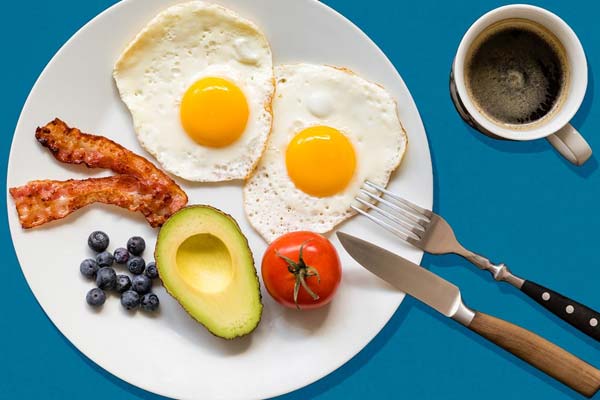كيتو دايت: كيف تحول جسمك إلى ماكينة حرق الدهون بطريقة طبيعية؟
كيتو دايت هو نظام غذائي شهير يركز على تقليل كمية الكربوهيدرات التي يتناولها الشخص وزيادة كمية الدهون والبروتينات. من خلال ذلك، يتم تحفيز الجسم على الدخول في حالة الكيتوز، وهي حالة تحرق الدهون بدلاً من الكربوهيدرات للحصول على الطاقة. يمكن أن يؤدي نظام الكيتو إلى فقدان الوزن وتحسين الصحة العامة، ولكن يتطلب الأمر اتباع نظام غذائي صحي ومتوازن.
يتميز نظام الكيتو بتقليل كمية الكربوهيدرات التي يتناولها الشخص، وهي مصدر رئيسي للطاقة في الجسم. يتم استبدال الكربوهيدرات بالدهون والبروتينات، وهي مصادر أخرى للطاقة. ومن خلال ذلك، يتم تحفيز الجسم على الدخول في حالة الكيتوز، وهي حالة تحرق الدهون بدلاً من الكربوهيدرات للحصول على الطاقة. وبالتالي، يمكن أن يؤدي نظام الكيتو إلى فقدان الوزن وتحسين الصحة العامة.
يحتاج الشخص الذي يتبع نظام الكيتو إلى تقليل كمية الكربوهيدرات وزيادة كمية الدهون والبروتينات في نظامه الغذائي. ومن المهم أن يتضمن نظامه الغذائي الخضروات والفواكه والمكسرات والبذور والألياف والماء للحصول على التغذية اللازمة. ويمكن أن يؤدي كيتو دايت إلى فوائد صحية، مثل تحسين مستويات الجلوكوز في الدم والتحكم في مرض السكري وتحسين مستويات الكوليسترول.
فوائد كيتو دايت
يعتبر كيتو دايت من الأنظمة الغذائية الشهيرة التي تساعد في إنقاص الوزن بشكل كبير، ولكن لا يقتصر فقط على ذلك، بل يحمل العديد من الفوائد الصحية الأخرى. يعمل النظام الغذائي كيتو على تقليل الكربوهيدرات في النظام الغذائي وزيادة الدهون والبروتينات، مما يحفز الجسم على الدخول في حالة الكيتوزيس التي تساعد في حرق الدهون بشكل أكبر.
تشمل فوائد النظام الغذائي كيتو ما يلي:
- إنقاص الوزن: يساعد كيتو دايت على إنقاص الوزن بشكل كبير، حيث يساعد في حرق الدهون بشكل أكبر وتقليل الشهية.
- تحسين صحة القلب: يمكن لكيتو دايت أن يساعد في تحسين صحة القلب، حيث يساعد على تقليل مستويات الكوليسترول والدهون في الدم.
- تحسين صحة الدم: يمكن للنظام الغذائي كيتو أن يساعد في تحسين صحة الدم، حيث يساعد على تقليل مستويات الجلوكوز في الدم وتحسين مستويات الأنسولين.
- تحسين صحة الدماغ: يمكن للنظام الغذائي كيتو أن يساعد في تحسين صحة الدماغ، حيث يساعد على تحسين وظائف الدماغ وتقليل خطر الإصابة بأمراض الدماغ مثل الزهايمر.
- تحسين صحة الجلد: يمكن للنظام الغذائي كيتو أن يساعد في تحسين صحة الجلد، حيث يساعد على تقليل الالتهابات وتحسين مرونة الجلد.
يجب على الأشخاص الذين يعانون من أمراض القلب والسكري استشارة الطبيب قبل البدء في النظام الغذائي كيتو، حيث يمكن أن يؤثر على بعض الأشخاص بشكل سلبي.
فوائد كيتو دايت لفقدان الوزن
يعتبر النظام الغذائي الكيتو من الأنظمة الغذائية الشهيرة والتي يتبعها الكثيرون لفقدان الوزن. ويتميز هذا النظام بأنه يقلل من تناول الكربوهيدرات ويزيد من تناول الدهون والبروتينات. ويؤدي ذلك إلى تحفيز الجسم على حرق الدهون لإنتاج الطاقة بدلاً من الكربوهيدرات. وفيما يلي بعض فوائد النظام الغذائي الكيتو لفقدان الوزن:
- يقلل من الشهية والجوع: يعتبر النظام الغذائي الكيتو من الأنظمة الغذائية الغنية بالبروتينات والدهون، والتي تساعد على الشعور بالشبع لفترة أطول، مما يقلل من الجوع والشهية، ويساعد في تناول كميات أقل من الطعام.
- يزيد من حرق الدهون: يعتمد النظام الغذائي الكيتو على تحفيز الجسم على حرق الدهون لإنتاج الطاقة، وهذا يساعد على فقدان الوزن بشكل أسرع، خاصة في المناطق التي تتراكم فيها الدهون بشكل أكبر.
- يحسن مستويات السكر في الدم: يعتمد النظام الغذائي الكيتو على تقليل تناول الكربوهيدرات، وهذا يساعد على تحسين مستويات السكر في الدم، ويساعد في الوقاية من الإصابة بأمراض السكري.
- يحسن مستويات الكوليسترول في الدم: يعتبر النظام الغذائي الكيتو من الأنظمة الغذائية الغنية بالدهون الصحية، والتي تساعد على تحسين مستويات الكوليسترول في الدم، وتقليل مخاطر الإصابة بأمراض القلب والأوعية الدموية.
- يزيد من الطاقة والتركيز: يعتمد النظام الغذائي الكيتو على حرق الدهون لإنتاج الطاقة، وهذا يساعد على زيادة مستويات الطاقة والتركيز، ويساعد في تحسين الأداء البدني والعقلي.
يجب الانتباه إلى أن النظام الغذائي الكيتو ليس مناسباً للجميع، وقد يؤدي إلى بعض المشاكل الصحية، ويجب استشارة الطبيب قبل البدء في تناوله.
فوائد كيتو دايت لصحة القلب والأوعية الدموية
تشير الدراسات إلى أن النظام الغذائي الكيتوني يمكن أن يكون فعالًا في تحسين صحة القلب والأوعية الدموية. وفيما يلي بعض الفوائد الصحية للنظام الغذائي كيتو:
- تحسين الإنسولين والجلوكوز: يمكن أن يساعد النظام الكيتوني في تحسين مستويات الإنسولين والجلوكوز في الدم، وهو ما يساعد في السيطرة على مرض السكري.
- تقليل الوزن: يمكن أن يساعد النظام الكيتوني في خفض الوزن، وهو ما يساعد في تحسين صحة القلب والأوعية الدموية.
- تحسين مستويات الدهون في الدم: يمكن أن يساعد النظام الكيتوني في تحسين مستويات الدهون في الدم، وهو ما يساعد في تقليل خطر الإصابة بأمراض القلب والأوعية الدموية.
- تحسين مستويات ضغط الدم: يمكن أن يساعد النظام الكيتوني في تحسين مستويات ضغط الدم، وهو ما يساعد في تقليل خطر الإصابة بأمراض القلب والأوعية الدموية.
- تحسين مستويات الكوليسترول: يمكن أن يساعد النظام الكيتوني في تحسين مستويات الكوليسترول في الدم، وهو ما يساعد في تقليل خطر الإصابة بأمراض القلب والأوعية الدموية.
- تقليل التهابات الجسم: يمكن أن يساعد النظام الكيتوني في تقليل التهابات الجسم، وهو ما يساعد في تحسين صحة القلب والأوعية الدموية.
على الرغم من أن النظام الغذائي الكيتوني يمكن أن يكون فعالًا في تحسين صحة القلب والأوعية الدموية، إلا أنه يجب استشارة الطبيب قبل البدء في هذا النظام الغذائي، خاصة إذا كان لديك أي مشاكل صحية مثل مرض السكري أو أمراض القلب والأوعية الدموية.
فوائد كيتو دايت لمرض السكري
نظام الكيتو الغذائي يعتبر من النظم الغذائية الفعالة جدًا لمرضى السكري، حيث يساعد في تخفيف الوزن وتحسين مستوى السكر في الدم بشكل كبير. وفيما يلي، سنستعرض بعض الفوائد الرئيسية لنظام الكيتو لمرضى السكري:
- تحسين مستوى السكر في الدم: يساعد كيتو دايت في تحسين مستوى السكر في الدم بشكل كبير، حيث يقلل من الحاجة للأنسولين ويحسن حساسية الجسم للأنسولين.
- تخفيف الوزن: يعد تخفيف الوزن أحد الفوائد الرئيسية لنظام الكيتو، وهو ما يساعد في السيطرة على مستوى السكر في الدم وتحسين حالة المريض.
- تحسين الصحة العامة: يساعد كيتو دايت في تحسين الصحة العامة للمريض، حيث يحسن من مستويات الدهون في الدم ويقلل من مستويات الكوليسترول الضار، ويقلل من خطر الإصابة بأمراض القلب والأوعية الدموية.
يجب الانتباه إلى أن نظام الكيتو ليس مناسبًا لجميع مرضى السكري، ويجب استشارة الطبيب قبل البدء في تناوله. كما يجب مراقبة مستويات السكر في الدم بشكل دقيق ومنتظم أثناء تناول نظام الكيتو.
فوائد كيتو دايت للحفاظ على صحة الدماغ
يعتبر نظام الكيتو الغذائي نظامًا غذائيًا شهيرًا يركز على تقليل كمية الكربوهيدرات المستهلكة وزيادة كمية الدهون المستهلكة. ومن بين الفوائد الصحية لنظام الكيتو الغذائي هي الفوائد التي تتعلق بصحة الدماغ.
تحسين وظائف الدماغ
يعتبر الكيتون، التي ينتجها الجسم عندما يحترق الدهون بدلاً من الكربوهيدرات، مصدرًا رئيسيًا للطاقة للدماغ. وهذا يعني أن نظام الكيتو الغذائي يمكن أن يساعد في تحسين وظائف الدماغ والذاكرة والتركيز.
الوقاية من الأمراض العصبية
وفقًا للعديد من الدراسات، فإن نظام الكيتو الغذائي يمكن أن يساعد في الوقاية من الأمراض العصبية مثل مرض الزهايمر ومرض باركنسون. ويرجع ذلك جزئيًا إلى الفوائد التي تتعلق بتحسين وظائف الدماغ.
تحسين حالة الصحة العامة
يمكن أن يساعد نظام الكيتو الغذائي في تحسين حالة الصحة العامة والوقاية من العديد من الأمراض المزمنة. ومن بين الأمراض التي يمكن أن يساعد في الوقاية منها نظام الكيتو الغذائي: السكري، وارتفاع ضغط الدم، والسمنة، وأمراض القلب، والتهاب المفاصل.
تحسين الحالة النفسية
يمكن أن يساعد نظام الكيتو الغذائي في تحسين الحالة النفسية والعاطفية. وفقًا للعديد من الدراسات، فإن نظام الكيتو الغذائي يمكن أن يساعد في تحسين حالات الاكتئاب والقلق والتوتر.
ما هو كيتو دايت؟
كيتو دايت، أو النظام الغذائي الكيتوني، هو نظام غذائي شهير يعتمد على تقليل نسبة الكربوهيدرات في النظام الغذائي بشكل كبير، والتركيز على الدهون والبروتينات. يهدف هذا النظام إلى تحفيز الجسم على الدخول في حالة فرط الكيتون الجسم أو الكيتوزيه، وهي حالة تحدث عندما ينخفض مستوى الكربوهيدرات في الجسم، ويبدأ الجسم في استخدام الدهون كمصدر للطاقة بدلاً من الكربوهيدرات.
يعتبر النظام الغذائي كيتو مناسبًا للأشخاص الذين يرغبون في خسارة الوزن بشكل سريع، وللأشخاص الذين يعانون من بعض الأمراض المزمنة مثل مرض السكري وارتفاع ضغط الدم والدهون الثلاثية في الدم. يمكن أن يساعد هذا النظام في تحسين مستويات السكر في الدم والكوليسترول، وتقليل الوزن الزائد.
يتميز النظام الغذائي كيتو بأنه يحتوي على نسبة عالية من الدهون ونسبة معتدلة من البروتينات، بينما يتم تقليل نسبة الكربوهيدرات إلى أقل من 50 جرامًا في اليوم. يمكن تناول الدهون من مصادر مختلفة مثل الأسماك الدهنية والمكسرات والزيوت النباتية والأفوكادو والزبدة.
يجب تجنب تناول الأطعمة الغنية بالكربوهيدرات مثل الحبوب والخبز والأرز والبطاطا، والتركيز على تناول الأطعمة الغنية بالبروتينات مثل اللحوم والدواجن والأسماك والبيض. يمكن أيضًا تناول الخضروات المنخفضة في الكربوهيدرات مثل السبانخ والبروكلي والخس والكرفس.
يجب الانتباه إلى أن النظام الغذائي كيتو ليس مناسبًا للجميع، ويجب استشارة الطبيب قبل البدء فيه، خاصةً للأشخاص الذين يعانون من بعض الأمراض المزمنة أو النساء الحوامل أو المرضعات.
الأطعمة المسموح بها والممنوعة في كيتو دايت
نظام الكيتو دايت يتطلب تقليل كمية الكربوهيدرات وزيادة كمية الدهون والبروتينات في النظام الغذائي اليومي. تحديد الأطعمة المسموح بها والممنوعة يساعد على تحقيق الهدف الغذائي بشكل أفضل.
الأطعمة المسموح بها
تعتبر نظام الكيتو دايت من الأنظمة الغذائية المعروفة بتقليل الكربوهيدرات وزيادة الدهون الصحية في النظام الغذائي. ومن المهم معرفة الأطعمة التي يمكن تناولها ضمن هذا النظام والتي تساعد على تحقيق الأهداف المرجوة.
البروتينات
تعد البروتينات من العناصر الأساسية في نظام الكيتو دايت، ويمكن الحصول عليها من اللحوم والدواجن والأسماك والبيض والمكسرات والحليب ومنتجات الألبان. ويجب الحرص على اختيار البروتينات الخالية من الدهون المشبعة والمعالجة.
الدهون
تعتبر الدهون الصحية من العناصر الأساسية في نظام الكيتو دايت، ويمكن الحصول عليها من الأفوكادو والمكسرات وزيت الزيتون والأسماك الدهنية والزبدة والجبن. ويجب الحرص على تناول الدهون بمعدل معتدل وعدم الإفراط في تناولها.
الخضروات
تعتبر الخضروات من العناصر الأساسية في نظام الكيتو دايت، ويمكن الحصول عليها من الخضروات الورقية والخضروات الخضراء والخضروات الملونة. ويجب الحرص على اختيار الخضروات القليلة بالكربوهيدرات والغنية بالألياف.
الفواكه
تعتبر الفواكه من الأطعمة التي يجب تجنبها في نظام الكيتو دايت بسبب احتوائها على نسبة عالية من الكربوهيدرات. ومن الفواكه المسموح بها في الكيتو دايت الأفوكادو والبطيخ والتوت والليمون والليمون الحامض والأناناس بكميات معتدلة.
المشروبات
يمكن تناول الماء والشاي والقهوة والمشروبات الغير محلاة في نظام الكيتو دايت. ويجب تجنب تناول المشروبات الغنية بالسكر والعصائر والمشروبات الغازية.
الأطعمة الممنوعة
تعد الأطعمة الممنوعة في الكيتو دايت من أهم الأمور التي يجب على الشخص الالتزام بها لتحقيق النتائج المرجوة. إذ يعتبر الكربوهيدرات هي العدو الأول لهذه الحمية، حيث يجب الحد من تناولها إلى أدنى حد ممكن. وفيما يلي بعض الأطعمة التي يجب تجنبها:
- الحبوب: تعتبر الحبوب من الأطعمة الغنية بالكربوهيدرات، وبالتالي يجب تجنب تناول الأرز والقمح والشوفان والذرة والشعير والشوفان والحبوب بشكل عام.
- الفواكه: يجب تجنب الفواكه الغنية بالسكريات، مثل العنب والموز والتمر والتين والتي تحتوي على نسبة عالية من الكربوهيدرات.
- الخضار النشوية: تحتوي بعض الخضروات على نسبة عالية من الكربوهيدرات، مثل البطاطا والجزر واليقطين واليام والذرة الحلوة.
- السكريات: يجب تجنب تناول الحلويات والمشروبات الغنية بالسكريات، مثل الشوكولاتة والحلويات والعصائر الصناعية والمشروبات الغازية.
- الدهون الضارة: يجب تجنب الدهون الضارة، مثل الزبدة والدهون المهدرجة والزيوت المهدرجة.
- المشروبات الكحولية: تحتوي المشروبات الكحولية على نسبة عالية من الكربوهيدرات، وبالتالي يجب تجنب تناولها.
بالإضافة إلى ما سبق، يجب تجنب تناول المشروبات الغازية والعصائر المحلاة والمنتجات الحلوة الأخرى. ويجب الحرص على قراءة تسميات المنتجات والتأكد من أنها لا تحتوي على نسبة عالية من الكربوهيدرات.
كيف يعمل كيتو دايت؟
يتميز النظام الغذائي كيتو بأنه يقلل من تناول الكربوهيدرات ويزيد من تناول الدهون والبروتين. وهذا يجعل الجسم يدخل في حالة الاستقلاب الكيتوني، حيث تنتج الكبد كمية من الكيتونات التي تستخدم كوقود بديل للجسم بدلاً من الجلوكوز.
ويؤدي تقليل تناول الكربوهيدرات إلى تقليل إفراز الأنسولين، وهو الهرمون الذي يساعد على تخزين الدهون في الجسم. وبالتالي، فإن النظام الغذائي كيتو يساعد على حرق الدهون بشكل أسرع.
ويقوم النظام الغذائي كيتو أيضًا بتنظيم مستويات السكر في الدم، حيث يقلل من الحاجة إلى الجلوكوز كمصدر للطاقة. وبالتالي، فإنه يمكن أن يساعد في تحسين صحة القلب والأوعية الدموية والتحكم في مستويات الكوليسترول.
ومن المهم أن يتم تناول مصادر جيدة للبروتين في النظام الغذائي كيتو، حيث يمكن أن يؤدي تناول كميات كبيرة من البروتين إلى عدم دخول الجسم في حالة الاستقلاب الكيتوني. ويمكن الحصول على البروتين من مصادر مثل اللحوم والأسماك والبيض والمكسرات والبذور.
ومن المهم أيضًا مراقبة تناول السعرات الحرارية في النظام الغذائي كيتو، حيث يجب تناول كمية كافية من السعرات الحرارية للحفاظ على وزن صحي، ولكن يجب تجنب تناول السعرات الحرارية الزائدة التي يمكن أن تؤدي إلى زيادة الوزن.
وبشكل عام، يمكن أن يكون النظام الغذائي كيتو فعالًا في إنقاص الوزن وتحسين الصحة العامة، ولكن يجب الحرص على تناول مجموعة متنوعة من المواد الغذائية والمواظبة على ممارسة النشاط البدني.
مخاطر كيتو دايت
يعتبر نظام الكيتو الغذائي من النظم الغذائية الشائعة في الأونة الأخيرة، والتي يتميز بتقليل تناول الكربوهيدرات وزيادة تناول الدهون والبروتينات. ومع ذلك، فإن هذا النظام الغذائي يحمل بعض المخاطر التي يجب على المتبعين لهذا النظام أخذها في الاعتبار.
مخاطر النظام الغذائي كيتو على المدى البعيد
يعتبر النظام الغذائي كيتو من النظم الغذائية المعتمدة على القصر الحاد في تناول الكربوهيدرات، وهو ما يؤدي إلى القلق بشأن مدى سلامة هذا النظام الغذائي على المدى البعيد. فعلى الرغم من أنه قد يساعد في فقدان الوزن وتحسين بعض الحالات الصحية، إلا أنه يمكن أن يؤدي إلى بعض المشاكل الصحية على المدى البعيد.
مخاطر النظام الغذائي كيتو وأمراض القلب
يوجد بعض الأبحاث التي تشير إلى أن النظام الغذائي كيتو يمكن أن يؤدي إلى زيادة خطر الإصابة بأمراض القلب، وذلك بسبب زيادة تناول الدهون والبروتينات وتقليل تناول الكربوهيدرات. ومع ذلك، فإن هذه الأبحاث لا تزال في مراحلها الأولية، ولم يتم العثور على دليل قاطع يؤكد هذه النتائج.
مخاطر النظام الغذائي كيتو والحالات الصحية
يجب على الأشخاص الذين يعانون من حالات صحية معينة مثل مرض السكري وأمراض الكبد والكلى وغيرها من الحالات الصحية الحرص على استشارة الطبيب قبل البدء في النظام الغذائي كيتو. وذلك لأن هذا النظام الغذائي يمكن أن يؤثر على مستويات السكر في الدم ومستويات الدهون في الكبد.
مخاطر النظام الغذائي كيتو والصحة العامة
يجب على المتبعين للنظام الغذائي كيتو الحرص على تناول الأطعمة الصحية التي تحتوي على العناصر الغذائية الأساسية، وتجنب تناول الأطعمة الغنية بالدهون المشبعة. وذلك لأن تناول الأطعمة الغنية بالدهون الم
مخاطر كيتو دايت الشائعة
يتميز نظام الكيتو بتقليل تناول الكربوهيدرات وزيادة تناول الدهون، وهو ما يمكن أن يؤدي إلى بعض المخاطر على الصحة. في هذا القسم، سوف نستعرض بعض المخاطر الشائعة لنظام الكيتو الغذائي.
- الإصابة بأنفلونزا الكيتو: يعاني بعض الأشخاص الذين يتبعون نظام الكيتو من أعراض شبيهة بأعراض الإنفلونزا، مثل الصداع والدوار والتعب. ويعتقد البعض أن هذا يحدث بسبب نقص الكربوهيدرات في النظام الغذائي، ولكن لا يوجد دليل قوي على ذلك.
- أضرار الكيتو دايت على الكليتين: تعتبر حصوات الكلى والقصور الكلوي من بين المخاطر الشائعة لنظام الكيتو الغذائي. يعتقد البعض أن هذا يحدث بسبب الإجهاد الزائد على الكلى لمعالجة البروتينات الزائدة في النظام الغذائي.
- أضرار الكيتو دايت على الجهاز الهضمي: يمكن أن يؤدي نظام الكيتو إلى بعض المشاكل الهضمية، مثل الإمساك والإسهال والغازات. ويعتقد البعض أن هذا يحدث بسبب نقص الألياف في النظام الغذائي.
- أضرار الكيتو دايت على نقص المغذيات: يمكن أن يؤدي نظام الكيتو إلى نقص بعض المغذيات الهامة، مثل الفيتامينات والمعادن، خاصة إذا لم يتم تناول مجموعة متنوعة من الأطعمة.
- أضرار الكيتو دايت على سكر الدم: يمكن أن يؤدي نظام الكيتو إلى انخفاض مستويات السكر في الدم، مما يمكن أن يؤثر على الصحة بشكل عام، ويزيد من خطر الإصابة بالإصابات والأمراض.
- أضرار الكيتو دايت على صحة العظام: يمكن أن يؤدي نظام الكيتو إلى نقص الكالسيوم في الجسم، وهو ما يمكن أن يؤثر على صحة العظام ويزيد من خطر الإصابة بالكسور.
- أضرار الكيتو دايت على العضلات: يعتبر نظام الكيتو من بين النظم الغذائية التي يمكن أن تؤدي إلى خس
مخاطر النظام الغذائي كيتو النادرة
تُعدّ حمية الكيتو من الأنظمة الغذائية الشائعة، والتي تعتمد على تقليل تناول الكربوهيدرات وزيادة تناول الدهون، مما يؤدي إلى إحداث تغييرات في الجسم، ولكن يجب الانتباه إلى بعض المخاطر النادرة التي يمكن أن تتسبب فيها هذه الحمية، ومن أبرزها:
ارتفاع مستويات الدهون في الدم
تؤدي حمية الكيتو إلى زيادة تناول الدهون، مما يمكن أن يؤدي إلى ارتفاع مستويات الدهون في الدم، وهو ما يعرف باسم الهيبرليبيميا، والتي يمكن أن تؤدي إلى مشاكل صحية مثل أمراض القلب والأوعية الدموية.
نقص العناصر الغذائية
تعتمد حمية الكيتو على تقليل تناول الكربوهيدرات، وهذا يمكن أن يؤدي إلى نقص العناصر الغذائية المهمة، مثل الألياف والفيتامينات والمعادن، والتي يمكن أن تؤدي إلى مشاكل صحية مثل الإمساك وضعف العظام.
الحالات النادرة
توجد بعض الحالات النادرة التي يمكن أن تتسبب فيها حمية الكيتو، مثل الحمى الكيتونية، والتي تحدث عندما يتم تراكم الكيتونات في الدم بشكل زائد، وهذا يمكن أن يؤدي إلى مشاكل صحية خطيرة، مثل الغيبوبة والوفاة.
الآثار الجانبية الأخرى
توجد بعض الآثار الجانبية الأخرى التي يمكن أن تحدث نتيجة اتباع حمية الكيتو، مثل الصداع والتعب والامتناع عن الأطعمة الحيوانية، والتي يمكن أن تؤدي إلى نقص بعض العناصر الغذائية المهمة.
لا يجب اتباع حمية الكيتو دون استشارة الطبيب المختص، ويجب الانتباه إلى بعض المخاطر النادرة التي يمكن أن تتسبب فيها هذه الحمية، والتي يجب الانتباه إليها لتجنب المشاكل الصحية المحتملة.
نصائح لاتباع كيتو دايت بنجاح
يعتبر النظام الغذائي كيتو من أشهر النظم الغذائية المتبعة حالياً، وذلك لأنه يساعد على إنقاص الوزن بشكل سريع وصحي، ويحسن من مستوى السكر في الدم ويقلل من الإصابة بأمراض القلب والسرطان. ولكن لتحقيق النتائج المرجوة، يجب اتباع بعض النصائح الهامة، ومنها:
- تحديد الهدف المرجو من النظام الغذائي كيتو، سواء كان إنقاص الوزن أو تحسين الصحة بشكل عام.
- الالتزام بتناول الوجبات الغذائية الصحية والمتوازنة، والتي تحتوي على البروتينات والدهون الصحية والخضروات المنخفضة الكربوهيدرات.
- الحرص على تناول الكربوهيدرات بشكل صحيح، وذلك عن طريق حساب الكربوهيدرات الصافية (net carbs) التي تحتوي عليها الأطعمة، والتي تعتبر الفرق بين إجمالي الكربوهيدرات والألياف.
- تجنب تناول الخبز والحبوب بشكل عام، واستبدالها بالخضروات المنخفضة الكربوهيدرات، والتي تحتوي على العديد من الفيتامينات والمعادن الضرورية للجسم.
- تجنب تناول الكحول بشكل كامل، أو تقليلها إلى الحد الأدنى الممكن، لأنها تحتوي على العديد من السعرات الحرارية التي تزيد من الوزن.
- تجنب الشعور بالجوع، وذلك عن طريق تناول الوجبات الصحية الغنية بالبروتينات والدهون الصحية، مثل اللحوم والأسماك والمكسرات والأفوكادو.
- شرب القهوة بدون سكر أو حليب، وذلك لأن السكر والحليب يحتويان على العديد من الكربوهيدرات التي تزيد من مستوى السكر في الدم.
باختصار، يحتاج الشخص الذي يريد اتباع النظام الغذائي كيتو إلى الالتزام بتناول الوجبات الصحية والمتوازنة، وتجنب الأطعمة الغنية بالكربوهيدرات، والحرص على تناول البروتينات والدهون الصحية، وتجنب الشعور بالجوع، وشرب القهوة بدون سكر أو حليب.
الخلاصة
تعتبر كيتو دايت (Keto Diet) من الحميات الغذائية المنخفضة الكربوهيدرات والعالية بالدهون. تتميز هذه الحمية بتقليل تناول الكربوهيدرات وزيادة تناول الدهون، مما يؤدي إلى دخول الجسم في حالة الكيتوز (Ketosis)، وهي حالة تستخدم فيها الدهون كمصدر أساسي للطاقة بدلاً من الكربوهيدرات.
يمكن أن تساعد الحمية الكيتونية في فقدان الوزن، حيث يؤدي تقليل الكربوهيدرات إلى تقليل مستويات السكر في الدم وتحفيز الجسم على حرق الدهون بشكل أكبر. كما أنها قد تساعد في تحسين الصحة العامة، حيث يمكن أن تساعد في تحسين مستويات الكولسترول وتقليل خطر الإصابة بالسكري.
من الأطعمة التي يمكن تناولها ضمن الحمية الكيتونية الأطعمة الغنية بالدهون مثل اللحوم والأسماك والأطعمة العالية بالبروتين مثل البيض والمكسرات والبذور. كما يمكن تناول الخضروات المنخفضة الكربوهيدرات مثل السبانخ والبروكلي والكرنب.
من الأفضل تجنب تناول الأطعمة الغنية بالكربوهيدرات مثل الحبوب والفواكه والأطعمة المصنعة. كما ينصح بتناول كميات كافية من الألياف وشرب الماء بكميات كافية.
يجب على الأشخاص الذين يعانون من مشاكل صحية مثل السكري وارتفاع مستويات الكولسترول استشارة الطبيب قبل البدء في الحمية الكيتونية.






